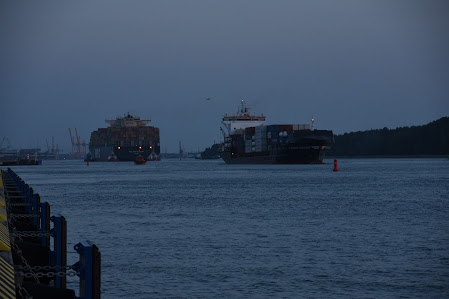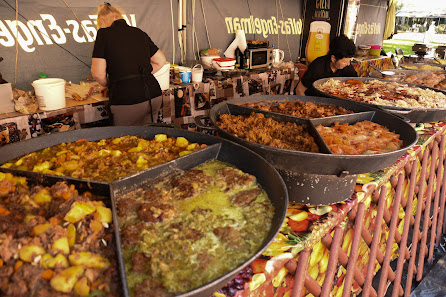To write these blogs after we travel I review my planning notes, photographs, and guidebooks to refresh what we've seen and learned. I also read additional history of the area and do some web searches to get my facts right and develop a theme for the post. My interest, and I hope my readers, is to add historical context to our travels to explain the why. However, in some places history is so complex that there is not a consistent through-line that goes from past to present. Latvia is one of those places.
The first tribal settlement near Riga were the Livs, which is why the region was called Livonia during the middle ages. Courland, which we'll visit after Riga, and the Couronian spit in Lithuania, are named after the Curonian (Kors) tribe along the coast, and the county is named after the Latgalian tribe. While researching I thought about how America's indigenous tribal names are not recognized by most of Americans, but they linger on in state names like Illinois, Minnesota, and Dakota, and place names like Huron, Manhattan and Duwamish.
The tribes of the Baltic.
Germans, Swedes, Russians, Poles, Prussians, Lithuanians and Soviet Union have all ruled parts of the area. Boggles my mind to neatly organize and summarize. As Rick Steves says in his guide book, "If Riga were a human, it would be keeping a stack of expired passports issued in its name by a dozen states and empires."
One example of how today's Latvia was divided, and the boarders and occupiers constantly changed.
After leaving Tartu in SE Estonia we drove SW across the boarder to the capital of Latvia, Riga. This has been the most important, and largest, city in the "Baltics" for centuries. During the Teutonic Rule it was settled as a bridgehead for the crusades against the northern pagans. The Hanseatic league established during this time was also founded by Germans in 1282 for trade monopoly between emerging Russia and the West.
When incorporated into Sweden, Riga was their largest holding, bigger than Stockholm. When Russia ruled Riga it became an industrial city in their effort to modernize like the West, and became their third largest city after Moscow and St. Petersburg. Following WWII the city lost its two largest communities, the Germans and the Jews, the former immigrating back to their ancestral lands, and the later massacred during the Holocaust. Yet the city continues to adapt, renew and thrive on the banks of the Daugava River leading to the Baltic.
For this post I'll mostly keep to our experiences.
In the center of Riga is Freedom Square anchored by Freedom Monument honoring soldiers killed during Latvia's war of Independence in 1918 - 1920. Like Finland and Estonia, Latvia did not exist as a nation state prior to the end of WWI. After WWII Soviets considered multiple times to tear the monument down but thought it would create too much unrest among the proud Latvians.
Statue of Liberty holding three stars atop obelisk and bas relief depicting Latvia's culture and history.
To contrast the independence monument, in 1971 the Soviets installed a monument to the Red Latvian Rifleman to honor the Latvian brigades that fought for the Bolsheviks against Germans, (in contrast to the White Latvian Riflemen who became disillusioned with the Bolsheviks fought against them). The monument is next to the Occupation Museum documenting Soviet atrocities, which was formerly a Soviet museum celebrating Soviet benefits. The monument was to be torn down after Latvia's independence in 1991, but instead was rededicated to both the White and Red Rifleman as Latvian heroes of WWI. History is written by the victors.

Three Rifleman in red granite and Soviet style sculpture.
All said, the proof of various political systems is in the pudding; there is no love lost for anything Russian or Soviet in their previously occupied countries.
This banner faces the Russian Embassy on what has been renamed Ukrainian Freedom Road.
Our first morning we took a boat ride along a man-made canal in the city center to the Daugava river which leads to the Baltic.
Lovely canal boat ride through the city.
View of modern Riga across the Daugava river from Old Town.
The next day we took an architectural tour of Old Town buildings from the 13th to the early 20th century. Since it's the holiday season I'll mention one tradition associated with Riga. On Christmas Eve in 1510 the Guild for unmarried merchants located in House of the Blackheads, shown below,
"were full of holiday spirit and hauled a pine tree up into the club house and smothereds it with flowers. At the end of the evening they burned the tree to the ground in an impressive blaze. From then on decorating the Christmas tree became an annual tradition." Rick Steves. Fortunately burning the tree intentionally did not catch on - so to speak.
The "House of the Blackheads". Originally from the 14th century, then the Brotherhood of the Blackheads, a guild for unmarried tradesmen. Destroyed by German and Soviet bombing in 1941 it was rebuilt over the original cellar in 1990.
"The Three Brothers" - the oldest residential buildings in Riga from the 15th to the 17th century.
Reminiscent of the Dutch architecture of the same period.
"Cat House" from the early 20th century. Medieval style with emerging Art Nouveau elements. Note the cats with arched backs on the top of the turrets. Legend is the owner was taking retribution at either the Great Guild across the street for some conflict, or at City Hall down the street following some dispute. Just think of wealthy people today posting on Twitter - er X.
While Tallinn is noted for its medieval core, Riga is noted for its abundance of Art Nouveau buildings. Over 750 of them, an acknowledged collection by UNESCO.
Classic ovoid window form on third floor center.
A Baroque form of Art Nouveau.
Very futuristic face form as decorative elements on the building above at the beginning of the machine age.
Riga Central Market. These five Zeppelin hangers were repurposed in the 1930 as Riga's Central Market,
and are now protected as a UNESCO site.
Amber is a major export for the nations around the Baltic.
Here're necklaces on display at the Central Market.
Adjacent to the Central Market is a major development for a new transportation hub.
Interestingly, it is both futuristic and modeled after the adjacent 100 year old Zeppelin hangers.
Our final dinner in Riga in one of the Old Town squares adjacent to the Cathedral.
After leaving Riga we drove NW along the coast through several resort towns that are an easy drive from the city. This time of year it was all pretty quiet. As in most of the "Baltics" the land is flat and heavily forested with sandy beaches along the coast. Though our drive was close to the coastline the forests limited any views of the water. Our destination was Cape Kola at the far NW tip of Latvia. The Cape separates the Gulf of Riga from the Irbe straight and the Baltic Sea.
Our drive took us NW from Riga to Cape Kolka then SW to Ventspils,
inland to Kuldiga, and back to the coast to Liepaja.
Boardwalk through the forest to the sandy Cape Kolka.
The shifting sands of the Cape's point.
The far NW tip of Latvia drifts into the Gulf of Riga - just because it's there.
Beautiful sand beaches along the Irbe Straight. Crowded in the summer.
As in Estonia, chanterelle mushrooms can be just picked up off the ground.
These fresh mushrooms in the US are $48/pound.
One of several "barrel cabins" you can rent for your beach stay.
Our night stop after leaving the cape was the city of Ventspils, population 42,000. Originally put off by its industrial port and no real commercial center, we eventually found we enjoyed its authenticity. They are developing the waterfront as a pleasant walkway, and there seems to be plenty for the locals and visitor alike. Our next day leaving many roads were closed for a 5K run.
Our guesthouse off a side street in Ventspils.
The death defying staircase to our upper guest-room.
Ventspils is a major transportation hub for gas and oil.
In 2002 they had an art exhibition of "Cows on Parade". There were about 20 throughout the city.
From her youthful Iowa days ratting cow tails, Robin has a thing for all things moo-velous.
On leaving Ventspils we headed inland to Kuldiga before heading back to the coast for our next night stay in Liepaja. Kuldiga boasts the widest waterfall in Latvia. The city was once the capital of Courland in the 16th century, but never recovered after the Great Northern war between Sweden and Russia. It's trapped in a time warp.
German influence is still evident in half timbered buildings.
The widest "waterfall" in Latvia. Not competing for height with anyplace.
Our final night in Latvia was in Liepaja on the coast of the Baltic Sea. We stayed in the Promenade hotel, converted from a spikeris (warehouse) on the canal leading to the Baltic. The canal walkway is lined with similar red bricked warehouses now catering to entertainment and restaurants. Liepaja has disproportionate number of major Latvian musicians. It wasn't much of a city until Tsar Alexander III deepened the harbor and built a major port in the 19th century. Under Soviet rule it was a major strategic military base. Today its main attraction (besides the canal ports and music) are the beautiful beaches.
Promenade Hotel for the night.
Boardwalk from the town to the sandy beaches.
The Courland coast exposed to the full western fetch of the Baltic can be quite windy,
acknowledged as such with this sculpture.
Wide sandy beaches were pretty much closed down except for occasional walkers like us.
Parts of the town are still pretty basic.
Yet, there is considerable infrastructure being rebuilt and a new concert hall -
in amber colored glass recalling their millennia of the precious export.
Next Post: The Baltic - Part Six, Lithuania






































































